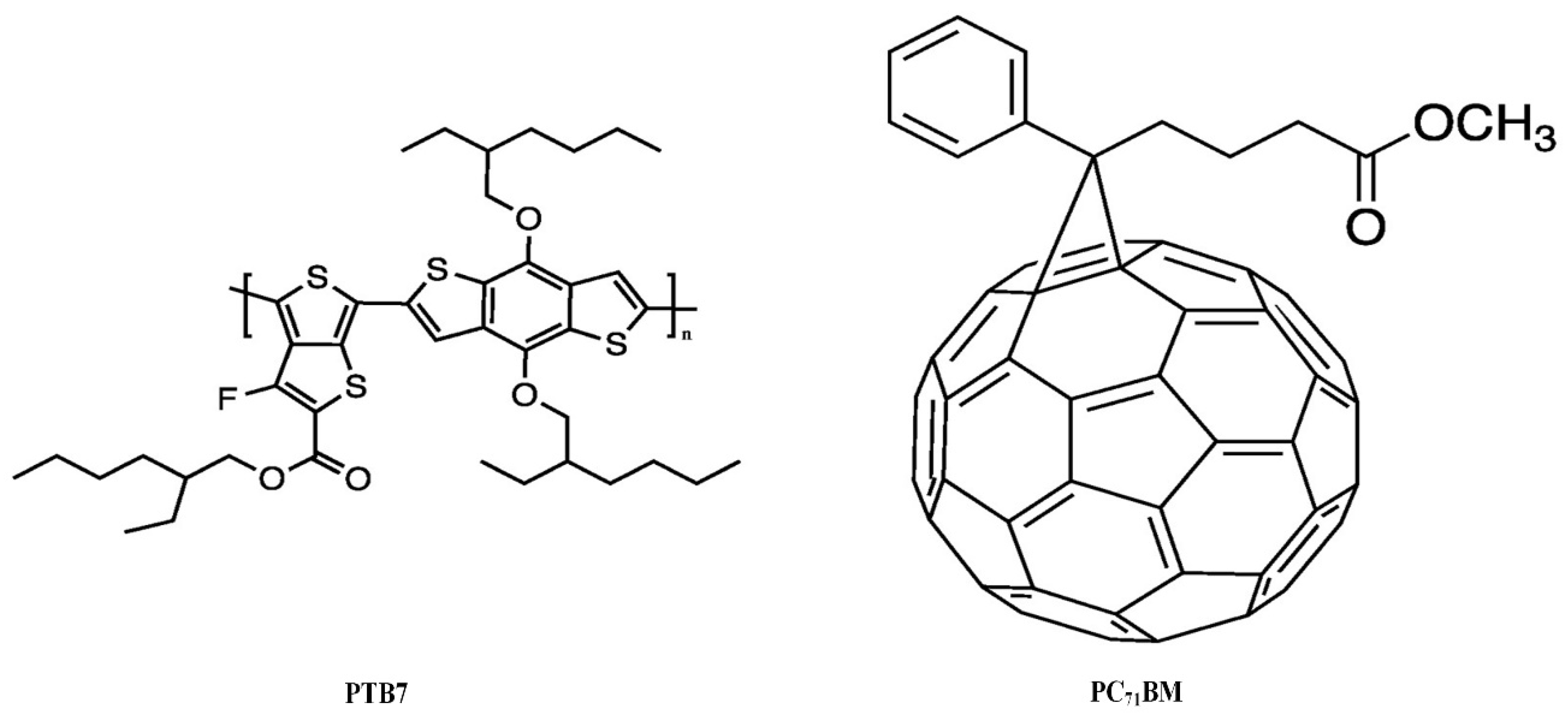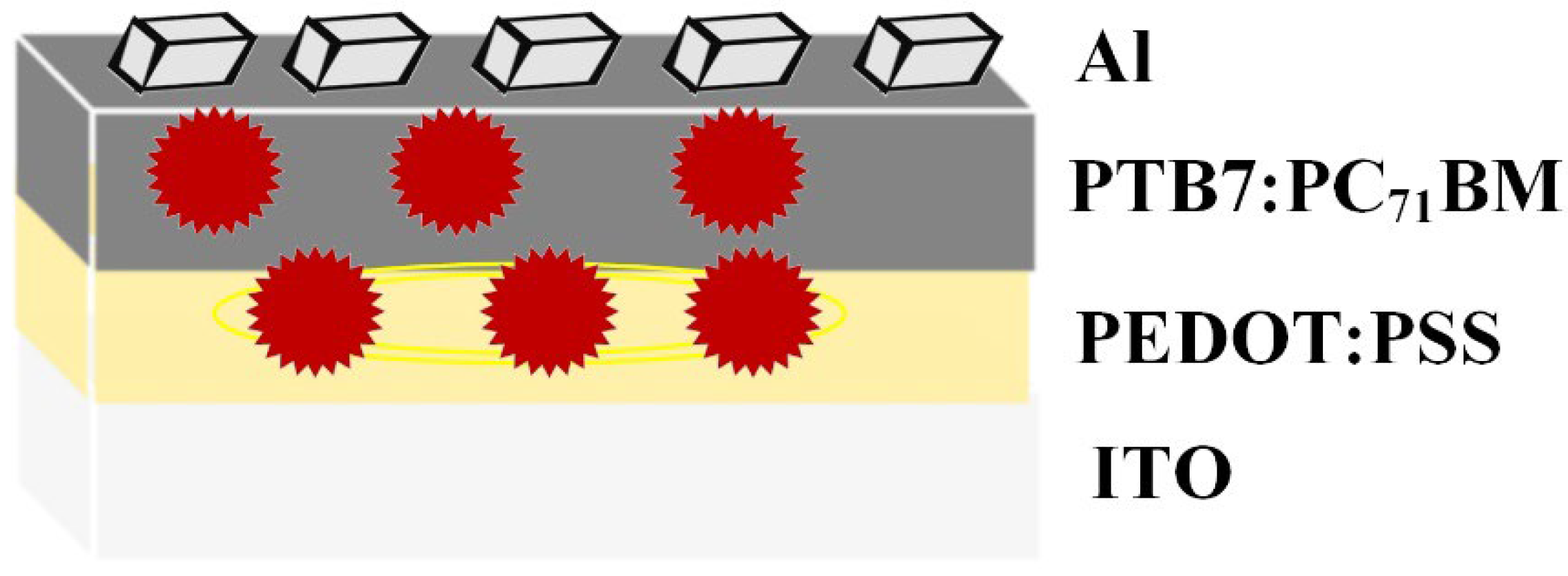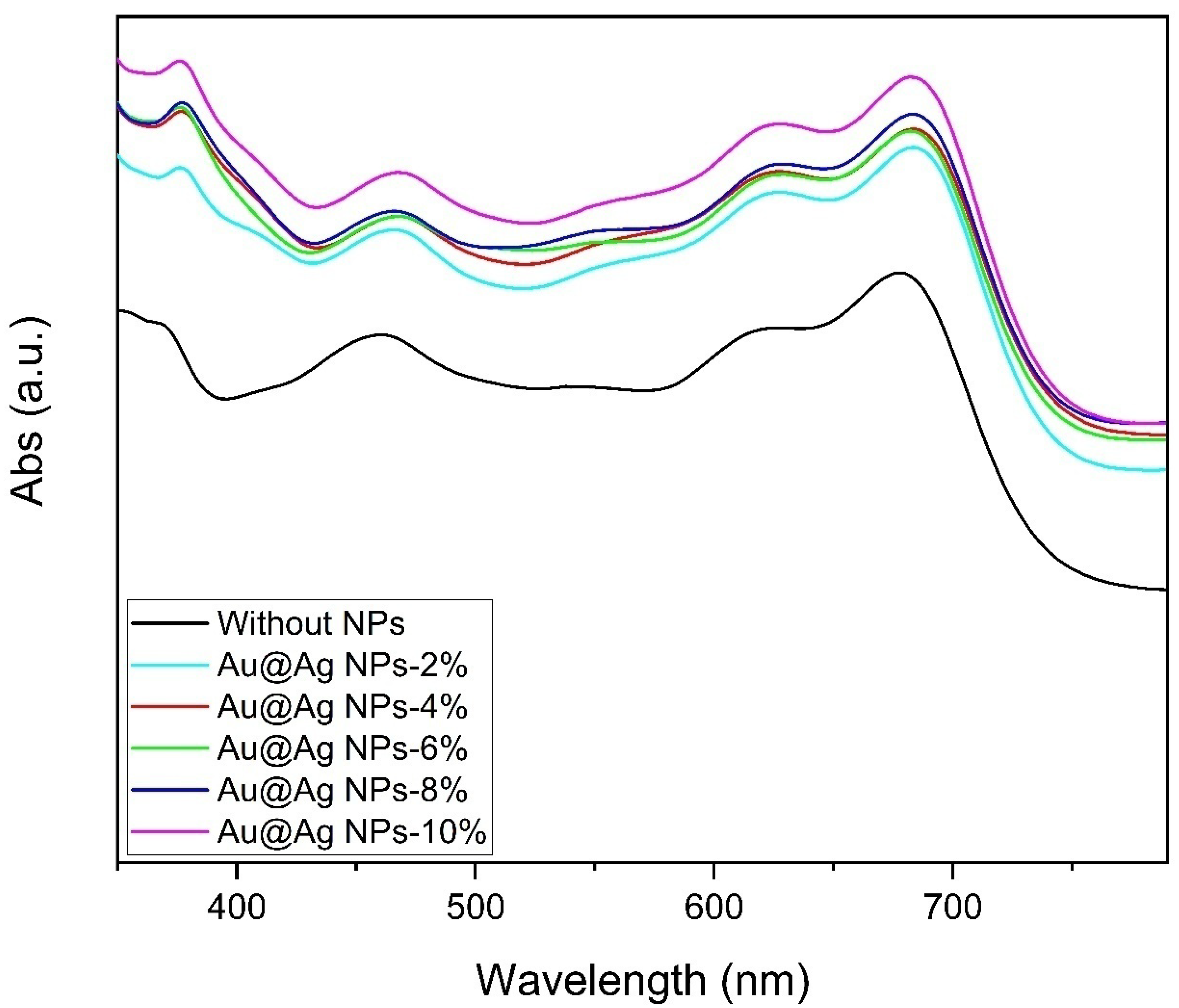Plasmonic Effects of Au@Ag Nanoparticles in Buffer and Active Layers of Polymer Solar Cells for Efficiency Enhancement
Abstract
:1. Introduction
2. Experimental Section
2.1. Materials
2.2. Synthesis of Core–Shell Au@Ag NPs
2.3. Fabrication of BHJ PSCs
2.4. Measurements
3. Results and Discussion
4. Conclusions
Author Contributions
Funding
Institutional Review Board Statement
Informed Consent Statement
Data Availability Statement
Conflicts of Interest
References
- Zidan, M.N.; Everitt, N.; Ismail, T.; Fahim, I.S. Organic solar cells parameters extraction and characterization techniques. Polymers 2021, 13, 3224. [Google Scholar] [CrossRef] [PubMed]
- Ameri, T.; Li, N.; Brabec, C.J. Highly efficient organic tandem solar cells: A follow up review. Energy Environ. Sci. 2013, 6, 2390–2413. [Google Scholar] [CrossRef]
- Yang, Y.; Zheng, Y.; Cao, W.; Titov, A.; Hyvonen, J.; Manders, J.R.; Xue, J.; Holloway, P.H.; Qian, L. High-efficiency light-emitting devices based on quantum dots with tailored nanostructures. Nat. Photonics 2015, 9, 259–266. [Google Scholar] [CrossRef]
- Liu, T.; Guo, Y.; Yi, Y.; Huo, L.; Xue, X.; Sun, X.; Fu, H.; Xiong, W.; Meng, D.; Wang, Z.; et al. Ternary organic solar cells based on two compatible nonfullerene acceptors with power conversion efficiency > 10%. Adv. Mater. 2016, 28, 10008–10015. [Google Scholar] [CrossRef]
- Ye, L.; Zhang, S.; Huo, L.; Zhang, M.; Hou, J. Molecular Design toward Highly Efficient Photovoltaic Polymers Based on Two-Dimensional Conjugated Benzodithiophene. Acc. Chem. Res. 2014, 47, 1595–1603. [Google Scholar] [CrossRef]
- Usmani, B.; Ranjan, R.; Gupta, S.K.; Gupta, R.K.; Nalwa, K.S.; Garg, A. Inverted PTB7-Th: PC71BM organic solar cells with 11.8% PCE via incorporation of gold nanoparticles in ZnO electron transport layer. Sol. Energy 2021, 214, 220–230. [Google Scholar] [CrossRef]
- Lee, S.; Jeong, D.; Kim, C.; Lee, C.; Kang, H.; Woo, H.Y.; Kim, B.J. Eco-Friendly Polymer Solar Cells: Advances in Green-Solvent Processing and Material Design. ACS Nano 2020, 14, 14493–14527. [Google Scholar] [CrossRef]
- Yin, H.; Yan, C.; Hu, H.; Ho, J.K.W.; Zhan, X.; Li, G.; So, S.K. Recent progress of all-polymer solar cells—From chemical structure and device physics to photovoltaic performance. Mater. Sci. Eng. R Rep. 2020, 140, 100542. [Google Scholar] [CrossRef]
- Je, H.I.; Shin, E.Y.; Lee, K.J.; Ahn, H.; Park, S.; Im, S.H.; Kim, Y.H.; Son, H.J.; Kwon, S.K. Understanding the performance of organic photovoltaics under indoor and outdoor conditions: Effects of chlorination of donor polymers. ACS Appl. Mater. Interfaces 2020, 12, 23181–23189. [Google Scholar] [CrossRef]
- Cui, Y.; Hong, L.; Hou, J. Organic photovoltaic cells for indoor applications: Opportunities and challenges. ACS Appl. Mater. Interfaces 2020, 12, 38815–38828. [Google Scholar] [CrossRef]
- Lee, B.R.; Goo, J.S.; Kim, Y.W.; You, Y.-J.; Kim, H.; Lee, S.-K.; Shim, J.W.; Kim, T.G. Highly efficient flexible organic photovoltaics using quasi-amorphous ZnO/Ag/ZnO transparent electrodes for indoor applications. J. Power Sources 2019, 417, 61–69. [Google Scholar] [CrossRef]
- Mainville, M.; Leclerc, M. Recent Progress on Indoor Organic Photovoltaics: From Molecular Design to Production Scale. ACS Energy Lett. 2020, 5, 1186–1197. [Google Scholar] [CrossRef]
- Teng, N.W.; Yang, S.S.; Chen, F.C. Plasmonic-enhanced organic photovoltaic devices for low-power light applications. IEEE J. Photovolt. 2018, 8, 752–756. [Google Scholar] [CrossRef]
- Xie, L.; Song, W.; Ge, J.; Tang, B.; Zhang, X.; Wu, T.; Ge, Z. Recent progress of organic photovoltaics for indoor energy harvesting. Nano Energy 2021, 82, 105770. [Google Scholar] [CrossRef]
- Alkhalayfeh, M.A.; Aziz, A.A.; Pakhuruddin, M.Z. An overview of enhanced polymer solar cells with embedded plasmonic nanoparticles. Renew. Sustain. Energy Rev. 2021, 141, 110726. [Google Scholar] [CrossRef]
- Alkhalayfeh, M.A.; Aziz, A.A.; Pakhuruddin, M.Z. Enhancing the efficiency of polymer solar cells by embedding Au@Ag NPs Durian shape in buffer layer. Sol. Energy 2020, 214, 565–574. [Google Scholar] [CrossRef]
- Agrawal, A.; Cho, S.H.; Zandi, O.; Ghosh, S.; Johns, R.W.; Milliron, D.J. Localized Surface Plasmon Resonance in Semiconductor Nanocrystals. Chem. Rev. 2018, 118, 3121–3207. [Google Scholar] [CrossRef]
- Mola, G.T.; Mthethwa, M.C.; Hamed, M.S.; Adedeji, M.A.; Mbuyise, X.G.; Kumar, A.; Sharma, G.; Zang, Y. Local surface plasmon resonance assisted energy harvesting in thin film organic solar cells. J. Alloy. Compd. 2021, 56, 158172. [Google Scholar] [CrossRef]
- Hamed, M.S.G.; Ike, J.N.; Mola, G.T. Plasmonic nano-particles mediated energy harvesting in thin-film organic solar cells. J. Phys. D Appl. Phys. 2021, 55, 015102. [Google Scholar] [CrossRef]
- Li, X.; Cao, Y.; Li, S.; Li, W.; Bo, Z. The preparation of plasmonic Au@ SiO2 NPs and its application in polymer solar cells. Mater. Lett. 2020, 268, 127599. [Google Scholar] [CrossRef]
- Shen, W.; Zhao, G.; Zhang, X.; Bu, F.; Yun, J.; Tang, J. Using Dual Microresonant Cavity and Plasmonic Effects to Enhance the Photovoltaic Efficiency of Flexible Polymer Solar Cells. Nanomaterials 2020, 10, 944. [Google Scholar] [CrossRef] [PubMed]
- Cho, H.-E.; Cho, S.H.; Lee, S.-M. Embedded plasmonic nanoprisms in polymer solar cells: Band-edge resonance for photocurrent enhancement. APL Mater. 2020, 8, 041116. [Google Scholar] [CrossRef] [Green Version]
- Tran, Q.N.; Lee, H.K.; Kim, J.H.; Park, S.J. Influence of Gold-Silver Rough-Surface Nanoparticles on Plasmonic Light Scattering in Organic Solar Cells. J. Nanosci. Nanotechnol. 2020, 20, 304–311. [Google Scholar] [CrossRef] [PubMed]
- Alkhalayfeh, M.A.; Aziz, A.A.; Pakhuruddin, M.Z.; Katubi, K.M. Recent advances of perovskite solar cells embedded with plasmonic nanoparticles. Phys. Status Solidi 2021, 218, 2100310. [Google Scholar] [CrossRef]
- Gollu, S.R.; Sharma, R.; Srinivas, G.; Kundu, S.; Gupta, D. Incorporation of silver and gold nanostructures for performance improvement in P3HT: PCBM inverted solar cell with rGO/ZnO nanocomposite as an electron transport layer. Org. Electron. 2016, 29, 79–87. [Google Scholar] [CrossRef]
- Zhang, R.; Zhou, Y.; Peng, L.; Li, X.; Chen, S.; Feng, X.; Guan, Y.; Huang, W. Influence of SiO2 shell thickness on power conversion efficiency in plasmonic polymer solar cells with Au nanorod@ SiO2 core-shell structures. Sci. Rep. 2016, 6, 25036. [Google Scholar] [CrossRef] [Green Version]
- Feng, B.; Sugiyama, I.; Hojo, H.; Ohta, H.; Shibata, N.; Ikuhara, Y. Atomic structures and oxygen dynamics of CeO2 grain boundaries. Sci. Rep. 2016, 6, 20288. [Google Scholar] [CrossRef] [Green Version]
- Noh, H.S.; Cho, E.H.; Kim, H.M.; Han, Y.D.; Joo, J. Organic solar cells using plasmonics of Ag nanoprisms. Org. Electron. 2012, 14, 278–285. [Google Scholar] [CrossRef]
- Chen, C.P.; Lee, I.C.; Tsai, Y.Y.; Huang, C.L.; Chen, Y.C.; Huang, G.W. Efficient organic solar cells based on PTB7/PC71BM blend film with embedded different shapes silver nanoparticles into PEDOT: PSS as hole transporting layers. Org. Electron. 2018, 62, 95–101. [Google Scholar] [CrossRef]
- Said, D.A.; Ali, A.M.; Khayyat, M.M.; Boustimi, M.; Loulou, M.; Seoudi, R. A study of the influence of plasmonic resonance of gold nanoparticle doped PEDOT: PSS on the performance of organic solar cells based on CuPc/C60. Heliyon 2019, 5, e02675. [Google Scholar] [CrossRef]
- Gao, H.; Meng, J.; Sun, J.; Deng, J. Enhanced performance of polymer solar cells based on P3HT: PCBM via incorporating Au nanoparticles prepared by the micellar method. J. Mater. Sci. Mater. Electron. 2020, 31, 10760–10767. [Google Scholar] [CrossRef]
- Gao, Y.; Jin, F.; Su, Z.; Zhao, H.; Luo, Y.; Chu, B.; Li, W. Cooperative plasmon enhanced organic solar cells with thermal coevaporated Au and Ag nanoparticles. Org. Electron. 2017, 48, 336–341. [Google Scholar] [CrossRef]
- Rezaei, B.; Afshar-Taromi, F.; Ahmadi, Z.; Rigi, S.A.; Yousefi, N. Enhancement of power conversion efficiency of bulk heterojunction polymer solar cells using core/shell, Au/graphene plasmonic nanostructure. Mater. Chem. Phys. 2019, 228, 325–335. [Google Scholar] [CrossRef]
- Ostrowski, J.C.; Mikhailovsky, A.; Bussian, D.A.; Summers, M.A.; Buratto, S.K.; Bazan, G.C. Enhancement of Phosphorescence by Surface-Plasmon Resonances in Colloidal Metal Nanoparticles: The Role of Aggregates. Adv. Funct. Mater. 2006, 16, 1221–1227. [Google Scholar] [CrossRef]
- Hsiao, Y.-S.; Charan, S.; Wu, F.-Y.; Chien, F.-C.; Chu, C.-W.; Chen, P.; Chen, F.-C. Improving the Light Trapping Efficiency of Plasmonic Polymer Solar Cells through Photon Management. J. Phys. Chem. C 2012, 116, 20731–20737. [Google Scholar] [CrossRef]
- Park, H.I.; Lee, S.; Lee, J.M.; Nam, S.A.; Jeon, T.; Han, S.W.; Kim, S.O. High performance organic photovoltaics with plasmonic-coupled metal nanoparticle clusters. ACS Nano 2014, 8, 10305–10312. [Google Scholar] [CrossRef]
- Liu, S.; Jiang, R.; You, P.; Zhu, X.; Wang, J.; Yan, F. Au/Ag core–shell nanocuboids for high-efficiency organic solar cells with broadband plasmonic enhancement. Energy Environ. Sci. 2016, 9, 898–905. [Google Scholar] [CrossRef] [Green Version]
- Nair, A.T.; Anoop, C.S.; Vinod, G.A.; Reddy, V.S. Efficiency enhancement in polymer solar cells using combined plasmonic effects of multi-positional silver nanostructures. Org. Electron. 2020, 86, 105872. [Google Scholar] [CrossRef]
- Wang, H.; Ding, Y.; Chen, W.; Liu, Y.; Tang, D.; Cui, G.; Li, W.; Shi, J.; Bo, Z. Broadband absorption enhancement in polymer solar cells using highly efficient plasmonic heterostructured nanocrystals. ACS Appl. Mater. Interfaces 2018, 10, 30919–30924. [Google Scholar] [CrossRef]
- Choi, H.; Lee, J.-P.; Ko, S.-J.; Jung, J.-W.; Park, H.; Yoo, S.; Park, O.; Jeong, J.-R.; Park, S.; Kim, J.Y. Multipositional Silica-Coated Silver Nanoparticles for High-Performance Polymer Solar Cells. Nano Lett. 2013, 13, 2204–2208. [Google Scholar] [CrossRef]
- Wang, D.H.; Park, K.H.; Seo, J.H.; Seifter, J.; Jeon, J.H.; Kim, J.K.; Park, J.H.; Park, O.O.; Heeger, A.J. Enhanced Power Conversion Efficiency in PCDTBT/PC70BM Bulk Heterojunction Photovoltaic Devices with Embedded Silver Nanoparticle Clusters. Adv. Energy Mater. 2011, 1, 766–770. [Google Scholar] [CrossRef]
- Kaçuş, H.A.; Aydoğan, Ş.; Biber, M.E.; Metin, Ö.N.; Sevim, M. The power conversion efficiency optimization of the solar cells by doping of (Au: Ag) nanoparticles into P3HT: PCBM active layer prepared with chlorobenzene and chloroform solvents. Mater. Res. Express 2019, 6, 095104. [Google Scholar] [CrossRef]
- Shabani, L.; Mohammadi, A.; Jalali, T. Numerical study of plasmonic effects of Ag nanoparticles embedded in the active layer on performance polymer organic solar cells. Plasmonics 2022, 17, 491–504. [Google Scholar] [CrossRef]
- Atwater, H.A.; Polman, A. Plasmonics for improved photovoltaic devices. In Materials for Sustainable Energy: A Collection of Peer-Reviewed Research and Review Articles from Nature Publishing Group; World Scientific: Singapore, 2011; pp. 1–11. [Google Scholar]
- Kim, C.-H.; Cha, S.-H.; Kim, S.C.; Song, M.; Lee, J.; Shin, W.S.; Moon, S.-J.; Bahng, J.H.; Kotov, N.A.; Jin, S.-H. Silver Nanowire Embedded in P3HT:PCBM for High-Efficiency Hybrid Photovoltaic Device Applications. ACS Nano 2011, 5, 3319–3325. [Google Scholar] [CrossRef] [PubMed]
- Ren, X.; Cheng, J.; Zhang, S.; Li, X.; Rao, T.; Huo, L.; Hou, J.; Choy, W.C. High Efficiency Organic Solar Cells Achieved by the Simultaneous Plasmon-Optical and Plasmon-Electrical Effects from Plasmonic Asymmetric Modes of Gold Nanostars. Small 2016, 12, 5200–5207. [Google Scholar] [CrossRef] [PubMed]
- Farooq, S.; Rativa, D.; de Araujo, R.E. Optimizing the Sensing Performance of SiO2-Au Nanoshells. Plasmonics 2019, 14, 1519–1526. [Google Scholar] [CrossRef]
- Lee, Y.H.; Kim, D.H.; Kim, T.W. Enhancement of the power conversion efficiency of organic photovoltaic cells due to Au@ SiO2 core shell nanoparticles embedded into a WO3 hole transport layer. Org. Electron. 2019, 68, 182–186. [Google Scholar] [CrossRef]
- Sun, Y.; Ren, G.; Han, S.; Zhang, X.; Liu, C.; Li, Z.; Fu, D.; Guo, W. Improving light harvesting and charge extraction of polymer solar cells upon buffer layer doping. Sol. Energy 2020, 202, 80–85. [Google Scholar] [CrossRef]
- Salim, M.B.; Nekovei, R.; Verma, A. Modeling of plasmonic organic solar cells using core-shell metallic nanoparticles. In 2020 IEEE 15th International Conference on Nano/Micro Engineered and Molecular System (NEMS); IEEE: Piscataway, NJ, USA, 2020; pp. 422–425. [Google Scholar]
- Alkhalayfeh, M.A.; Aziz, A.A.; Pakhuruddin, M.Z.; Katubi, K.M.M. Spiky Durian-Shaped Au@Ag Nanoparticles in PEDOT:PSS for Improved Efficiency of Organic Solar Cells. Materials 2021, 14, 5591. [Google Scholar] [CrossRef]
- Chang, F.; Li, H.; Zheng, B.; Qian, K.; Lei, Q.; Han, G.; Song, Y.; Shao, P. Effect of silver nanospheres embedded in buffer layer based on organic solar cells. J. Mater. Sci. Mater. Electron. 2017, 29, 1349–1355. [Google Scholar] [CrossRef]
- Xu, M.; Yan, L.; Zhu, Y.; Li, Y.; Song, X.; Yin, L. Polydopamine-coated gold nanoparticles used as modifier of the electron transport layer for PTB7:PC71BM polymer solar cells. J. Mater. Sci. Mater. Electron. 2020, 31, 6698–6705. [Google Scholar] [CrossRef]







| No. | Au@Ag NPs in PEDOT:PSS | Au@Ag NPs in PTB7:PC71BM | Jsc (mA/cm2) | Voc (mV) | Jmax (mA/cm2) | Vmax (mV) | FF (%) | PCE (%) |
|---|---|---|---|---|---|---|---|---|
| 1 | Without NPs | Without NPs | 11.82 | 685.8 | 6.27 | 400 | 30.9 | 2.50 |
| 2 | Au@AgNPs14% | Au@AgNPs-2% | 19.03 | 697.3 | 10.44 | 400 | 31.5 | 4.17 |
| 3 | Au@AgNPs-14% | Au@AgNPs-4% | 19.20 | 699.0 | 10.60 | 400 | 31.6 | 4.24 |
| 4 | Au@AgNPs-14% | Au@AgNPs-6% | 18.60 | 694.0 | 10.13 | 400 | 31.4 | 4.05 |
| 5 | Au@AgNPs-14% | Au@AgNPs-8% | 17.58 | 696.1 | 9.57 | 400 | 31.3 | 3.83 |
| 6 | Au@AgNPs-14% | Au@AgNPs-10% | 15.90 | 698.4 | 8.63 | 400 | 31.1 | 3.45 |
| No. | NPs | Location of MNPs | Relative Improvement in PCE (%) | Ref. |
|---|---|---|---|---|
| 1 | Ag nanospheres | In PEDOT:PSS | 33 | [51] |
| 2 | Au nanosphere | In PEDOT:PSS | 24 | [52] |
| 3 | Ag nanostructures | In ZnO and PTB7: PCBM | 15 | [37] |
| 4 | Au@PDA | On ITO | 30 | [30] |
| 5 | Ag-decahedron | In PEDOT:PSS | 12 | [28] |
| 6 | Au:Ag | On ITO | 22.5 | [31] |
| 7 | Au nanostars | In PEDOT:PSS | 10.7 | [53] |
| 8 | Au@Ag | In PEDOT:PSS and PTB7:PC71BM | 69.6 | - |
Publisher’s Note: MDPI stays neutral with regard to jurisdictional claims in published maps and institutional affiliations. |
© 2022 by the authors. Licensee MDPI, Basel, Switzerland. This article is an open access article distributed under the terms and conditions of the Creative Commons Attribution (CC BY) license (https://creativecommons.org/licenses/by/4.0/).
Share and Cite
Alkhalayfeh, M.A.; Aziz, A.A.; Pakhuruddin, M.Z.; Katubi, K.M.M. Plasmonic Effects of Au@Ag Nanoparticles in Buffer and Active Layers of Polymer Solar Cells for Efficiency Enhancement. Materials 2022, 15, 5472. https://doi.org/10.3390/ma15165472
Alkhalayfeh MA, Aziz AA, Pakhuruddin MZ, Katubi KMM. Plasmonic Effects of Au@Ag Nanoparticles in Buffer and Active Layers of Polymer Solar Cells for Efficiency Enhancement. Materials. 2022; 15(16):5472. https://doi.org/10.3390/ma15165472
Chicago/Turabian StyleAlkhalayfeh, Muheeb Ahmad, Azlan Abdul Aziz, Mohd Zamir Pakhuruddin, and Khadijah Mohammedsaleh M. Katubi. 2022. "Plasmonic Effects of Au@Ag Nanoparticles in Buffer and Active Layers of Polymer Solar Cells for Efficiency Enhancement" Materials 15, no. 16: 5472. https://doi.org/10.3390/ma15165472
APA StyleAlkhalayfeh, M. A., Aziz, A. A., Pakhuruddin, M. Z., & Katubi, K. M. M. (2022). Plasmonic Effects of Au@Ag Nanoparticles in Buffer and Active Layers of Polymer Solar Cells for Efficiency Enhancement. Materials, 15(16), 5472. https://doi.org/10.3390/ma15165472






